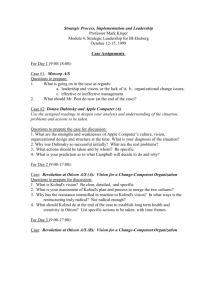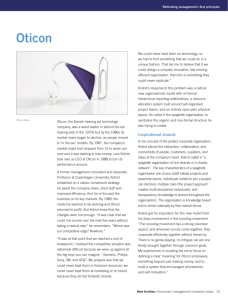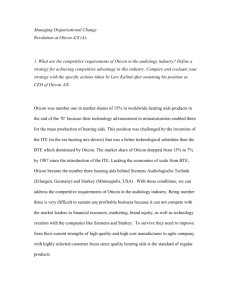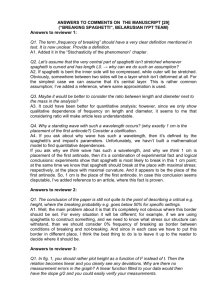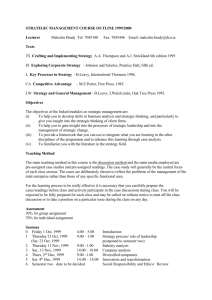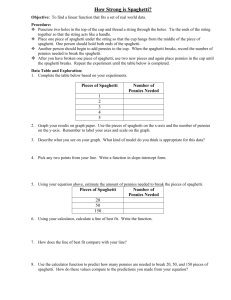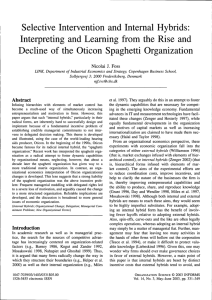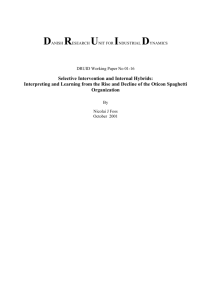Internal Hybrids as Sources of Competitive Advantage: A Note on
advertisement
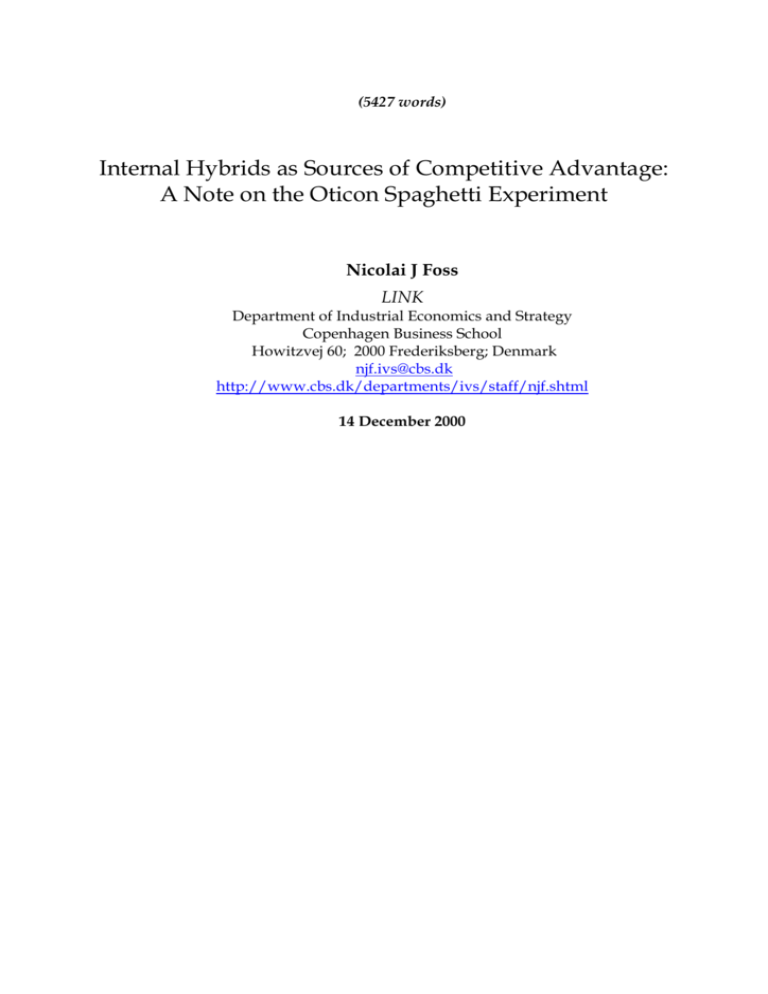
(5427 words) Internal Hybrids as Sources of Competitive Advantage: A Note on the Oticon Spaghetti Experiment Nicolai J Foss LINK Department of Industrial Economics and Strategy Copenhagen Business School Howitzvej 60; 2000 Frederiksberg; Denmark njf.ivs@cbs.dk http://www.cbs.dk/departments/ivs/staff/njf.shtml 14 December 2000 Internal Hybrids as Sources of Competitive Advantage: A Note on the Oticon Spaghetti Experiment Abstract Lovas and Ghoshal (2000) developed the notion of “strategy as guided evolution,” using the case of Oticon A/S. This note points out that the radical “spaghetti” organization described by Lovas and Ghoshal has been partially abandoned in Oticon. Developing an organizational economics interpretation of this episode, the present note argues that there are important implications for the understanding of the conditions under which internal hybrids may be viable and contribute to competitive advantage. The main focus in on the managerial commitment problem. Testable propositions are derived. 1 Introduction Increasingly, organizational structure is seen as an important source of sustained competitive advantage. In particular, much attention has been devoted lately to how firms by combining coordination mechanisms (Helper, MacDuffie and Sabel 2000) in novel ways can design organizational structures that foster entreprenerial initiative and helps to integrate and build knowledge, while keeping agency costs at bay (Miles and Snow 1992; Zenger and Hesterly 1997; Day and Wendler 1998; Mosakowski 1998). In overall terms, these unconventional ways of combining coordination mechanisms amount to infusing hierarchies with coordination mechanisms characteristic of the market (i.e., internal hybrids) or of infusing market relations with coordination mechanisms characteristic of the hierarchy (i.e., external hybrids) (Zenger and Hesterly 1997). For example, Helper et al. (2000: 443) describe how firms in the US auto industry are capable of building “pragmatic relationships” which allow them to “… continuously improve their joint products and processess without the need for a clear division of property rights,” and which “… both advance knowledge and control opportunism.” These relationships are clearly examples of external hybrids. However, firms may also use internal hybrids to reach the goals of advancing knowledge while controlling opportunism. An example of this has recently been described by Lovas and Ghoshal (2000) for the purpose of developing a notion of “strategy as guided evolution.” They use the case of the decision-making processes and administrative systems (i.e., the organization of task division) in the Danish hearing aids producer, Oticon A/S. Oticon became world-famous for its radical delegation and empowerment experiment ⎯ implemented in 1991 and aptly marketed as the ”spaghetti organization” ⎯, which introduced “… revolutionary new assumptions of what it meant to work and how one worked” (Gould 1994: 456). To many observers, Oticon seemed to be an outstanding example of achieving integration and recombination of knowledge by means of loosely coupled administrative systems that were explicit seen as hard-to-replicate sources of competitive advantage (Gould 1994). In fact, a 2 small cottage industry has recently emerged on the Oticon spaghetti experiment as an example of how dynamic capabilities may be grown on the basis an almost pure project-based organization, and how strategy may emerge from (partly steered) evolutionary processes in such an organization (particularly Lovas and Ghoshal 2000; Ravasi and Verona 2000; Verona and Ravasi 1999). However, recent accounts of the Oticon spaghetti organization fail to note that the spaghetti organization in its initial radical form (as described, e.g., in Lovas and Ghoshal 2000) does not exist anymore in Oticon ⎯ it has been superceded by more structured administrative systems (“Oticon ⎯ Spaghetti and Beyond”). In the organizational economics interpretation briefly developed in the following, the Oticon spaghetti experiment foundered on a number of design mistakes that relate to the problem of introducing market mechanisms in hierarchies (Williamson 1985; Baker, Gibbons, and Murphy 1999, 2000) and which necessitated a move to more structured administrative system. In particular, the “steering” by management discussed by Lovas and Ghoshal (2000) in actuality turns out to have created deepseated incentive problems (“Why Was the Spaghetti Organization Changed?”). This suggests that some care should be exercised when using the case of Oticon to develop managerial prescriptions relating to the adoption of internal hybrids with the aim of fostering dynamic capabilities (Ravasi and Verona 2000; Verona and Ravasi 1999) or conceptualizing strategy as guided evolution. More positively, it suggests that managerial commitment problems (Miller 1992; Williamson 1996; Baker, Gibbons and Murphy 1999, 2000) may be crucial to the understanding of the contribution of organizational structure to competitive advantage (“Implications for Internal Hybrids and Competitive Advantage”). 3 Oticon – Spaghetti and Beyond1 Oticon: The Spaghetti Organization Founded in 1904 and based mainly in Denmark, Oticon (now William Demant Holding A/S) is a world leader in the hearing aids industry.2 For a number of years in the beginning to the mid-1990s, Oticon became one of the best-known and admired examples of radical organizational turnaround. The turnaround aimed increasing employee empowerment and responsibility, reducing product development cycles, increasing contact to customers, mobilizing dispersed and “hidden” existing knowledge, and building new knowledge. These goals would be reached by means of a radical project-based organizational structure that should be explicitly “knowledge-based” (Kolind 1990) and “anthropocentric,” yet based on “free market forces” (Lyregaard 1993). It should be capable of combining and recombining skills in a flexible manner, where skills and other resources would move to those (new) uses where they were most highly valued. The new organization amounted to breaking down the earlier functional department-based organization into an almost completely flat, almost 100 percent project-based organization. Departments gave way to “competence centers” (e.g., in mechanical engineering, audiology, etc.) that broke with the boundaries imposed by the old departments. Rather than being assigned tasks from the above, employees now had a choice to decide which projects they would join. All projects were to be announced on an electronic bulletin board, where employees who would like to join them could sign in. The much noted “multi-job” principle meant, first, that employees were not restricted in the number of projects they could, and, second, that The following is based on archival sources, newspaper and magazine articles, an interview with Oticon HRM manager, Henrik Holck and correspondence with former CEO, Lars Kolind (both in June 2000), as well as the large number of very rich and thick descriptions of Oticon that have been produced by a number of mainly Danish academics, journalists and Oticon insiders throughout the 1990s (in particular, Lyregaard 1993; Poulsen 1993; Morsing 1995; Morsing and Eiberg 1998; Eskerod 1997, 1998; Jensen 1998; Foss and Hertz 2000). 1 The history of Oticon prior to the introduction of the spaghetti organization is extensively covered in Poulsen (1993) and Morsing (1995), and, briefer, in Gould (1994) and Lomas and Ghoshal (2000: 877878). 2 4 employees were actively encouraged (and in the beginning actually required) to develop and include skills outside their skill portfolio. Project managers were free to manage the project as they preferred, and accordingly received a considerable amount of decision making power. For example, they received the right to negotiate salaries.3 The project team was required to undertake all the tasks connected with product development until the product was successfully introduced in all markets.. Finally, although project teams were self-organizing and basically left to mind their own business once their projects were ratified, they were still to meet with a ”Project and Product Committee” once every three months for ongoing project evaluation.4 Interpreting Spaghetti From an organizational economics point of view, the immediately noticeable aspect of the spaghetti organization is the importance of the market metaphor in the design of the new administrative structure (Lyregaard 1993). In the Oticon simulation of the market, employees were given many and far-reaching decision rights. Development projects could be initiated by, in principle, any employee, just like entrepreneurs in a market setting. Project groups were self-organizing in much the same way that, for example, partnerships are self-organizing. The setting of salaries was decentralized to project leaders. Most hierarchical levels were eliminated and formal titles done away with, etc. Thus, the intention was that the organization should mimic the market in such dimensions as flexibility, autonomy, flatness, etc. A major problem that besets centralized decision-making systems ⎯ in large firms as well as in centralized economies ⎯ is that they have difficulties efficiently mobilizing and utilizing important local knowledge, such as the precise characteristics of specific processes, employees, machines, or customer preferences. As Hayek (1945) explained, the main problem is that much of this knowledge is 3 Although the variance on the distribution of salaries was increased as a result of the new reward schemes that characterized the spaghetti organization, average salaries do not appear to have changed. Complementary measures were taken to back up these initiatives. For example, Kolind introduced an employee stock program, which was motivated by the need to raise needed additional money for the transformation, and he invested 26 millions DKK of his own funds in Oticon. 4 5 transitory, fleeting and/or tacit, and therefore costly to articulate and transfer to a (corporate) center. Markets are not plagued by these type problems to the same extent. Rather than involving the transfer of costly-to-transfer knowledge to those with decision rights (as in a command economy or a centralized firm), markets tend to economize on the costs of transferring knowledge by instead allocating decision rights to those who possess the relevant knowledge (Hayek 1945; Jensen and Meckling 1992). The Oticon spaghetti organization was very much an attempt to mimic the market in these dimensions. Thus, a basic problem in the old organization had been that commercially important knowledge simply didn’t reach the relevant decisionmakers. By giving project teams extensive decision rights, making ideas for projects public and requiring that teams/project groups possessed the necessary complementary skills for a particular marketing, research or development task, the spaghetti organization stimulated a co-location of decision rights with local knowledge. Those who held the relevant knowledge were also to have the authority to decide over the use of company resources, at least within limits. Decision Rights It is the same co-location that takes place in a well-functioning market. However, Oticon remained a firm; its use of “free market forces” (Lyregaard 1993) was fundamentally a simulation, for the full decentralization of decision rights that characterizes market organization never took place in Oticon (and neither could it). In lieu of a distinct price mechanism that could coordinate actions, the market-like spaghetti organization was to be kept together by a shared set of values (Kolind 1994), advanced information technology, the charismatic leadership of CEO Lars Kolind himself, and, last but certainly not least, by a committee, staffed by Kolind and three other managers, the primary purpose of which was to approve of or reject proposed projects (the Projects and Products Committee). This committee, as well as the strongly overlapping top management committee, were the real holders of power ⎯ they possessed ultimate decision rights. 6 In general, firms confront a problem that markets confront to a smaller degree, namely that of making sure that decision rights are utilized efficiently, in other words, the problem of moral hazard. There was no apriori guarantee that project leaders and other employees would act in the interest of the firm. Several of the components of the spaghetti organization may be seen as responses to this fundamental agency problem. The rights to allocate resources to a particular project may be broken down into the rights to 1) initiate a project, 2) ratify projects, 3) implement projects, and 4) monitor and evaluate projects (cf. Fama and Jensen 1983). For reasons of efficiency, firms usually don’t concentrate these rights in the same hands; rather initiation and implementation rights may be controlled by one person (or team) while ratification and monitoring rights are controlled by other persons, usually hierarchical superiors.5 This allocation of control rights corresponds to that of the Oticon spaghetti organization. Thus, anybody could make initiate a project, in the sense of sketching, making preliminary plans, doing the required calculations, making contacts, etc. However, projects had to be evaluated by the Products and Projects Committee (“PPC”) that was staffed by Kolind, the development manager, the marketing manager and the support manager- The Project and Products Committee was the real holder of power in Oticon. Frequent intervention on the part of the Committee ex post made that clear to everybody. Project teams were required to report to the Committee on a three months basis, and the Committee could at any time halt or close down projects, something which happened quite frequently. Thus, decision management (i.e., initiation and daily project management) was separated from decision control (i.e., project evaluation and monitoring). The internal market was, in actuality, very much a managed one. Although a considerable amount of variety was indeed allowed to evolve, the selection over this variety was very much guided by the visible hand of the PPC (Lovas and Ghoshal 2000). Exceptions may occur when giving subordinates more extensive rights (e.g., a package of initiation, ratification and implementation rights) strengthens employee incentives (see Aghion and Tirole 1997; Baker, Gibbons and Murphy 1999 for analyses of this). 5 7 Retreating From Spaghetti A retreat from the radical spaghetti organization that Kolind had implemented in 1991 began long before he resigned as CEO in 1998. In 1996, Oticon headquarters was divided into three “business teams” (“Team Advanced,” “Team Technology,” and “Team High Volume”) which function as overall administrative units around projects. Each business team is managed by two team leaders, namely a technician and a person with marketing or human resource skills. These teams refer directly to Niels Jakobsen, the new CEO. In addition to the business teams, a “Competence Center” is in charge of all projects and their financing and of an operational group controlling administration, IT, logistics, sales and exports. It is one of the successors to the abandoned Project and Products Committee; however, its style of managing the projects is very different. In particular, care is taken to avoid the erratic behavior with respect to intervening in already approved of projects that characterized the PPC. The team leaders and the head of the Competence Center comprise, together with the CEO, the “Development Group,” which essentially is the senior executive group and is in charge of overall strategy making. Much of the initiative with respect to starting new projects is taken by the Development Group. Many of the decisionmaking rights held earlier by project leaders have now been concentrated in the hands of the Competence Center, or the managers of the business teams. Project leaders are appointed by the Competence Center; the right to be a project leader is not something that one grabs, as under the spaghetti organization. Although multijobs/multi-tasking are still allowed, this practice is no longer directly encouraged, and its prevalence has been much reduced. Although Oticon is still characterized by considerable decentralization and delegation of rights, many of the crucial elements of the spaghetti organization have been left. What happened? 8 Why Was the Spaghetti Organization Changed? Some Basic Design Problems An organizational economics perspective suggests that although the spaghetti organization was characterized by substantial coherence obtaining between its complementary elements, it was still beset by a number of problems that may arguably have been among the causes of its partial abandonment about five years later. First, the spaghetti organization eliminated most hierarchical levels, leading to a problem of the allocation of managerial competence. Hierarchy couldn’t be used anymore as a sorting mechanism for allocating skills so that those with more decisive knowledge would obtain authority over those with less decisive knowledge (Casson 1994). Second, from an incentive perspective, the extremely flat spaghetti organization sacrificed an incentive instrument, since it abolished tournaments between managers. Third, the multi-job led to severe coordination problems, because project leaders had very little guarantee that they could actually carry a project to its end, given that anybody at the project could leave at will, if noticing a superior opportunity in the internal job market. Apparently, reputation mechanisms were not sufficient to cope with this problem. Fourth, contrary to aim of making Oticon a knowledge-sharing environment, knowledge tended to be held back within projects, because of the widespread, and correct, perception that projects were essentially in competition over resources. Monitoring systems apparently couldn’t cope satisfactorily with these problems.6 Fifth, influence activities (Milgrom 1988) were important under the spaghetti organization. Personal relations to those who staffed the Committee became paramount for having a project ratified by the Committee Possibly as a reflection of these problems, the most crucial variable with respect to determining salary changes in the present organization is the degree to which an employee contributes to knowledge-sharing. 6 9 (Eskerod 1998: 80).7 However, the perhaps most important incentive problem related to the behavior of the PPC. Selective Intervention in Oticon Few writers on internal hybrids ⎯ such as the Oticon spaghetti organization ⎯ recognize the incentive problem that in the literature goes under the name of the ”impossibility of (efficient) selective intervention.”8 Oliver Williamson (1996:150) describes this as … a variant on the theme, “Why aren’t more degrees of freedom always better than less?.” In the context of firm and market organization, the puzzle is, “Why can’t a large firm do everything that a collection of small firms can and more.” By merely replicating the market the firm can do no worse than the market. And if the firm can intervene selectively (namely, intervene always but only when expected net gains can be projected), then the firm will sometimes do better. Taken together, the firm will do at least as well as, and will sometimes do better than, the market. Williamson flatly argues that selection intervention is ”impossible.” Incentives are diluted, because the option to intervene ”… can be exercised both for good cause (to support expected net gains) and for bad (to support the subgoals of the intervenor)” (Williamson 1996: 150-151). Promises to only intervene for good cause can never be credible, because they are unenforcable. However, the conclusion that ”selective intervention” is strictly impossible may not be correct. It is in fact conceivable that the intervenor may credibly commit to not intervene in such a way that the ”subgoals of the intervenor” are promoted. The logic may be exemplified as follows (cf. Baker, Gibbons and Murphy 1999). Assume that a subordinate initiates a project, and that the manager has information that is necessary to perform an assessment of the project, but that he decides upfront Foss (2000) discusses whether these design mistakes were remediable, concluding that they were not. 7 10 to ratify any project that the subordinate proposes. Effectively, this amounts to full informal delegation of the rights to initiate and ratify projects.9 Because the subordinate values being given freedom, this will induce more effort in searching for new projects (Aghion and Tirole 1997). The expected benefits of these increased efforts may overwhelm the expected costs from bad projects that the manager has to ratify. However, the problem is that because the manager has information about the state of a project (”bad” or ”good”), he may be tempted to renege on a promise to delegate decision authority, that is, intervene in a “selective” manner. But if he overrules the subordinate, the latter will lose trust in him, holding back on effort. In this game a number of equilibria are feasible, as determined by te discount rate of the manager, the specific trigger strategy followed by the sub-ordinate (e.g., will he lose trust in the manager for all future periods if he is overruled?), and how much the manager values his reputation for not reneging relative to the benefits of reneging on a bad project. It is arguable that one of the reasons why the spaghetti organization was changed into a more hierarchical organization has to do with the sort of problems described by notions of selective intervention. Thus, the official rhetoric of a flexible market-based structure, with substantial autonomy and the management team (i.e., the PPC) acting as little more than facilitator and coordinator (Kolind 1990; Lyregaard 1993), was increasingly at odds with the frequent selective intervention on the part of the PPC. Selective intervention was partly motivated by the fact that the “…PPC does not make general written plans, which are accessible to the rest of the organization … if this were done, plans would have to be adjusted or remade in an ever-continuing process, because the old plans had become outdated” (Eskerod 1998: 80). Thus, instead of drafting and continuously revise plans under the impact of changing contingencies, the PPC preferred to intervene directly in projects. In fact, Day and Wendler (1998) is an exception. The impossibility of selective intervention problem is just one of a broader class of managerial commitment problems; see Miller (1992). 8 “Informal,” because the formal right to ratify is still in the hands of the manager and because that right cannot be allocated to the subordinate through a court-enforceable contract (cf. Williamson 1996). 9 11 this was taken by the PPC to be a quite natural feature of a flexible, project-oriented organization (Eskerod 1998: 89). However, it also led to diluted incentives and strongly harmed intrinsic motivation (as documented at length by Eskerod 1997, 1998). The present Oticon organization is characterized by a much more consistent approach towards projects on the part of the Competence Center (one of the descendants of the PPC). Projects are rarely stopped or abandoned, and there is a stated policy of sticking to ratified projects. First, projects now rest on generally more secure ground, having been more carefully researched beforehand. Second, the wish to avoid harming motivation (i.e., diluting incentives) by overruling going projects is strongly stressed. Apparently, present Oticon management has realized the need to credibly commit to a policy of non-interference with going projects. In contrast, one of the main problems of the old spaghetti organization was that Kolind and the PPC never committed in this way; neither, apparently, did they intend to do so. Kolind’s view appears to have been that in important respects and in many situations, they were likely to possess the decisive overall knowledge, and that efficient utilization of resources dictated intervening in, and sometimes closing down, projects. However, that view clashed on a basic level with the rhetoric of widespread delegation of decision rights. Implications for Internal Hybrids and Competitive Advantage There is empirical evidence of an increasing adoption of internal hybrids (Mendelsson and Pillai 1999; Zenger and Hesterly 1997). Proponents of internal hybrids argue that these forms are particularly likely sources of competive adantages under knowledge-intensive conditions. As Miles et al. (1997: 7) argue: A number of leading companies today are experimenting with a new way of organizing – the cellular form. Cellular organizations are built on the principles of entrepreneurship, self-organization, and member ownership. 12 In the future, cellular organizations will be used in situations requiring continuous learning and innovation. Similar arguments were invoked by the proponents of the Oticon spaghetti organization (Kolind 1990, 1994; Lyregaard 1993). In turn, this suggests that we may learn something from the Oticon experience about the limits to internal hybrids. Zenger (1997: 4) argues that attempts to infuse hierarchies with coordination mechanisms characteristic of market organization often ”… violate patterns of complementarity that support traditional hierarchy as an organizational form.” For example, managers implement new structures without new performance measures and new pay systems, or they implement new pay systems without developing new performance measures. The present note has illustrated the importance as well as the difficulty of “getting (all) the complementarities right.” Thus, although the spaghetti organization consisted of highly complementary organizational elements (Foss 2000), this was not sufficient to secure its viability. The fundamental problem was that the importance of the managerial commitment problem was not recognized, or at least not recognized as a part of the problem of achieving complementarity between organizational elements. It has been suggested that designing a radical internal hybrid, such as the spaghetti organization, is extremely hard. The fundamental problem is that decentralizing an organization by means of delegation of rights to carry out certain actions (hiring, training, sourcing, pricing, etc.) remains a “simulation” (Day and Wendler 1998). It can never really be market exchange, because, unlike independent agents in markets, corporate employees never possess ultimate decision rights (Hart 1995). They are not full owners. This means that those who possess ultimate decision rights can always overrule employees. Thus, credibly committing to a policy of decentralization and delegation is a major problem for top-management. suggests the following proposition: 13 This Proposition 1: The contribution of an internal hybrid to competitive advantage will be strongly influenced by top-management’s exercise of their ultimate decision rights (e.g., as measured by the frequency of their intervention). Thus, erratic intervention in decentralized projects will harm incentives and cause employees to hold back on knowledge building and sharing efforts. Moreover, since managerial commitment is inherently hard to build and imitate (Barney 1991), we may put forward the following proposition: Proposition 2: Committing to managerial policies of non-interference with projects/teams in internal hybrid forms is a source of sustained competitive advantage. Essentially, the commitment problem of internal hybrids arises because such hybrids are organized under an authority structure. Ultimately, the meaning of being a boss is that one can restrict the decisions of a subordinate, overrule him and perhaps fire him. In turn, this means that although decision rights may be delegated, we can still trace the chain of authority in a firm, and we will always realize that ultimate decision-making power resides at the top. Ulimate decision-making rights can only be transferred from bosses to subordinates in one way, namely by transferring ownership (Hart 1995). However, transferring ownership amounts to spinning off the person to whom ownership is given. It means creating a new firm. The advantage of such external disaggregation relative to internal hybrids is that it eliminates the managerial commitment problem. The implication is not that firms should never adopt internal hybrids. Considerations of knowledge sharing or asset specificity may overwhelm the effects of weakened incentives inside firms. However, firms should always consider external disaggregation as an strong alternative to internal hybrids (disaggregation), suggesting the following proposition: Proposition 3: Firms that manage internal and external hybrids as substitutes will be more profitable than other firms, ceteris paribus. 14 Conclusions To many firms, the adoption of new and unconventional internal and external hybrids is increasingly seen as important sources of competitive advantage. The present note has discussed a specific internal hybrid episode in the light of organizational economics. The Oticon spaghetti organization accomplished in a number of ways what it was intended to, notably an increase in innovativeness. However, it has been suggested that a number of inefficiencies were present in that administrative structure, which led to a more hierarchical structure being adopted. In particular, the attempt to simulate the market in Oticon foundered on the basic problem of doing so. One of the main rationales of firms is exactly that they may avoid the high-powered incentives that characterize markets (Williamson 1985; Holmström and Milgrom 1991), and structure monitoring and reward schemes in ways that are generally not available to markets (Holmström 1999). Arguably, the spaghetti organization was carried too far in its emulation of the market. Moreover, there was a basic problem of credible commitment, one that centered on the apparent inconsistency between a policy and rhetoric of widespread delegation, emphasis on responsibility, etc. on the one hand, and a managerial practice of shifting priorities and intervention and closing down of projects on the other hand. An overall theoretical implication of the reasoning in this note is that it matters whether knowledge-based networks are organized within or across the boundaries of the firm (cf. Baker, Gibbons and Murphy 2000). First, incentives differ between markets and firms. Knowledge sharing is not necessarily best stimulated by marketbased project organization. To the extent that knowledge sharing is a hard-to- measure performance variable, employees are likely to put less of an emphasis on this. Upon realizing this, resort to lower-powered incentives is likely (Holmström 1999). Second, it remains the case that markets don’t rely on resource-allocation by means of authority whereas firms do. Whatever their stated policies of ”empowerment” etc., in firms all subordinates’ decision rights “are loaned, not owned” (Baker, Gibbons and Murphy 1999: 56). With 15 respect to managerial implications, the usual implication of organizational economics is to “get the incentives right.” In contrast, the present note has stressed “get complementarities right,” and particularly “make commitment credible.” Testable propositions can be derived from this perspective. References Baker, George, Robert Gibbons, and Kevin J. Murphy. 1999. ”Informal Authority in Organizations,” Journal of Law, Economics and Organization 15: 56-73. Baker, George, Robert Gibbons, and Kevin J. Murphy. 2000. “Relational Contracts and the Theory of the Firm,” unpublished manuscript. Barney, Jay B. 1991. “Firm Resources and Sustained Competitive Advantage,” Journal of Management 17: 99-120. Baron, James N. and David M. Kreps. 1999. “Consistent Human Resource Practices,” California Management Review 41: 29-53. Børsens Nyhedsmagasin. ”Opgør med Kolinds kaos,” 8. November 1999: 14-22. Casson, Mark. 1994. “Why are Firms Hierarchical?,” International Journal of the Economics of Business 1: 47-76. Day, Jonathan and Jim Wendler. 1998. ”The New Economics of Organization,” McKinsey Quarterly: 4-18. Eskerod, Pernille. 1997. Nye perspektiver på fordeling af menneskelige ressourcer i et projektorganiseret multiprojekt-miljø. Ph.d. dissertation. Sønderborg: Handelshøjskole Syd. Eskerod, Pernille. 1998. ”Organising by Projects: Experiences From Oticon’s Product Development Function,” in Morsing, Mette and Kristian Eiberg, eds. 1998. Managing the Unmanageable For a Decade. Hellerup: Oticon. Fama, Eugene and Michael C. Jensen 1983. ”Separation of Ownership and Control,” Journal of Law and Economics 26: 301-325. Foss, Nicolai J. 2000. “Internal Disaggregation in Oticon: Interpreting and Learning from the Oticon Spaghetti Experiment,” manuscript. Foss, Nicolai J. and Louise Hertz. 2000. ”Cogitate Incognita ⎯ The Rise and (Partial) Decline of the Oticon Spaghetti Organization,” case, Copenhagen Business School. Gould, R. Morgan. 1994. “Revolution at Oticon A/S: The Spaghetti Organization,” in Soumitra Dutta and Jean-Francois Manzoni, eds. 1999. Process Re-engineering, Organizational Chnage and Performance Improvement. London: McGraw-Hill. 16 Grant, Robert M. 1996. “Prospering in Dynamically Competitive Environments: Organizational Capability as Knowledge Integration,” Organization Science 7: 375-387. Hart, Oliver. 1995. Firms, Contracts and Financial Structure. Oxford: Clarendon Press. Hayek, Friedrich A. von. 1945. ”The Use of Knowledge in Society,” in idem. 1948. Individualism and Economic Order, Chicago: University of Chicago Press. Helper, Susan, John Paul MacDuffie, and Charles Sabel. 2000. “Pragmatic Collaborations: Advancing Knowledge While Controlling Opportunism,” Industrial and Corporate Change 9: 443-487. Holmström, Bengt. 1999. “The Firm as a Subeconomy,” Journal of Law, Economics, and Organization 15: 74-102. Holmström, Bengt and Paul Milgrom. 1991. “Multitask Principal-Agent Analyses: Incentive Contracts, Asset Ownership, and Job Design,” Journal of Law, Economics and Organization 7: 24-52. Jensen, Frank Dybdal. 1998. Værdibaseret Ledelse – styring mellem regler og visioner. Copenhagen: Jurist- og Økonomforbundets Forlag. Jensen, Michael C. and William H. Meckling. 1992. “Specific and General Knowledge and Organizational Structure,” in Lars Werin and Hans Wijkander, eds. 1992. Contract Economics. Oxford: Blackwell. Kolind, Lars. 1990. ”Think the Unthinkable,” in Mette Morsing and Kristian Eiberg, eds. 1998. Managing the Unmanageable For a Decade. Hellerup: Oticon. Kolind, Lars. 1994. “The Knowledge-Based Enterprise,” in Mette Morsing and Kristian Eiberg, eds. 1998. Managing the Unmanageable for a Decade. Hellerup: Oticon. Lovas, Bjorn and Sumantra Ghoshal. 2000. “Strategy as Guided Evolution,” Strategic Management Journal 21: 875-896. Lyregaard, Poul-Erik. 1993. ”Oticon: Erfaringer og faldgruber,” in Steen Hildebrandt and Leif H. Alken, eds. På vej mod helhedssyn i ledelse. Ankerhus. Miles, Raymond E. and Charles C. Snow. 1992. ”Causes of Failure in Network Organizations,” California Management Review: 53-72. Miles, Raymond E., Charles C. Snow, John A. Mathews, Grant Miles and Henry J. Coleman, Jr. 1997. “Organizing in the Knowledge Age: Anticipating the Cellular Form,” Academy of Management Executive 11: 7-20. Milgrom, Paul. 1988. “Employment Contracts, Influence Activities and Efficient Organization Design,” Journal of Political Economy 96:42-60. Milgrom, Paul and John Roberts. 1990. “The Economics of Modern Manufacturing: Technology, Strategy and Organization,” American Economic Review 80: 511-528. Miller, Gary. 1992. Managerial Dilemmas. Cambridge: Cambridge University Press. Morsing, Mette. 1995. Omstigning til Paradis? Oticon i processen fra hierarki til spaghetti. Copenhagen: Copenhagen Business School Press. 17 Morsing, Mette. 1998. “Conflicts as the Driving Force in Project Organizations,” in Mette Morsing and Kristian Eiberg, eds. 1998. Managing the Unmanageable For a Decade. Hellerup: Oticon. Morsing, Mette and Kristian Eiberg, eds. 1998. Managing the Unmanageable For a Decade. Hellerup: Oticon. Mosakowski, Elaine. 1998. “Entrepreneurial Resources, Organizational Choices, and Competitive Outcomes,” Organization Science 9: 625-643. Poulsen, Per Thygesen. 1993. Tænk det utænkelige – revolutionen i Oticon. Copenhagen: Schultz. Ravasi, Davide and Gianmario Verona. 2000. “Organizing the Process of Knowledge Integration: The Benefits of Structural Ambiguity,” forthcoming in Scandinavian Journal of Management. Verona, Gianmario and Davide Ravasi. 1999. “Organizational Capabilities for Continuous Innovation,” unpublished manuscript. Williamson, Oliver E. 1996. The Mechanisms of Governance. Oxford: Oxford University Press. Zenger, Todd. 1997. “Crafting Internal Hybrids,” unpublished manuscript. Zenger, Todd and William S. Hesterly. 1997. “The Disaggregation of Corporations: Selective Intervention, High-Powered Incentives, and Molecular Units,” Organization Science 8: 209-222. 18
